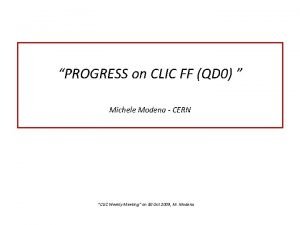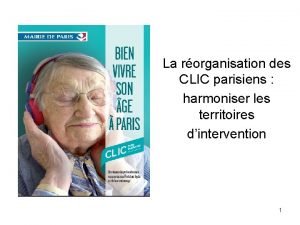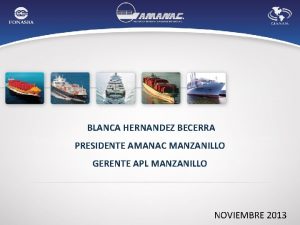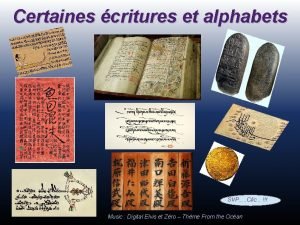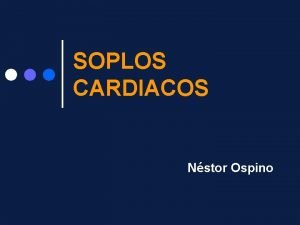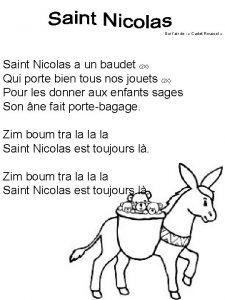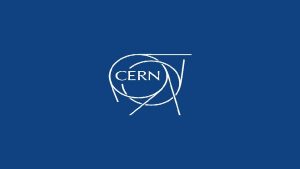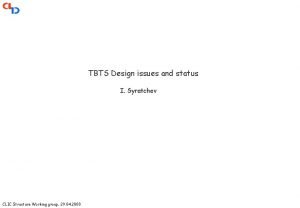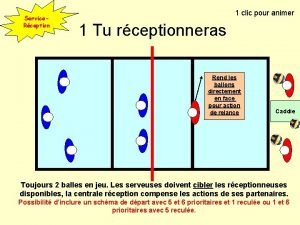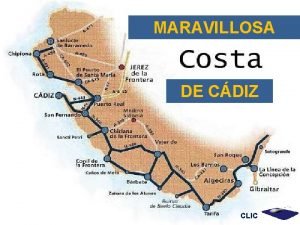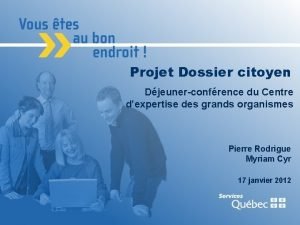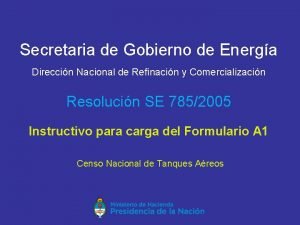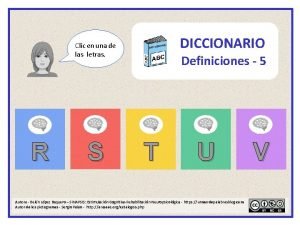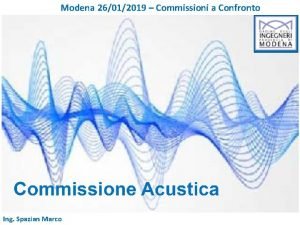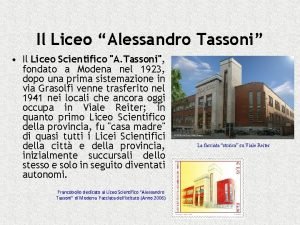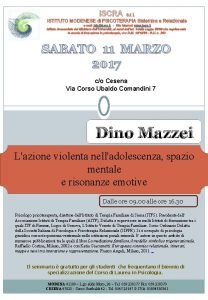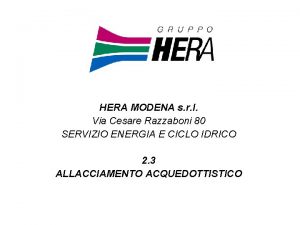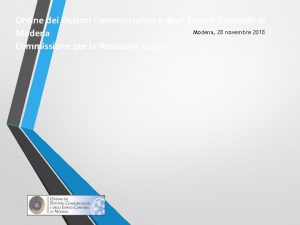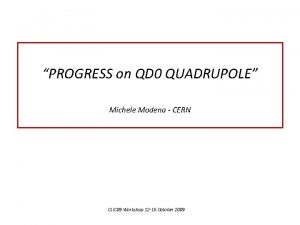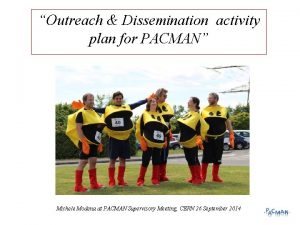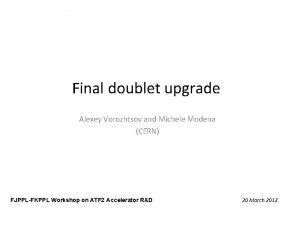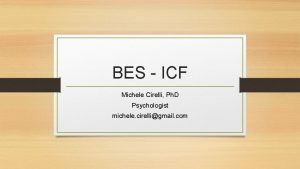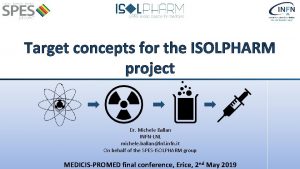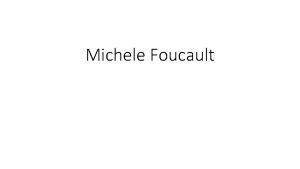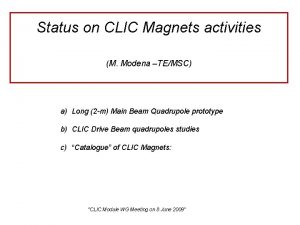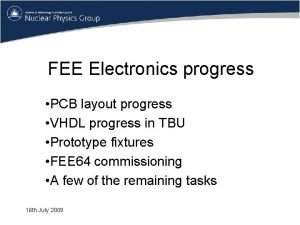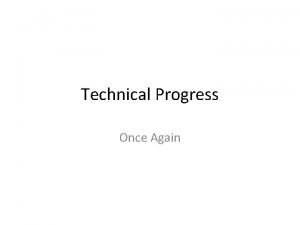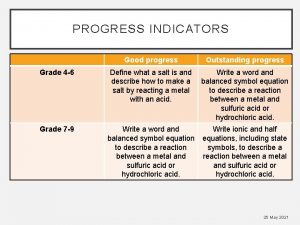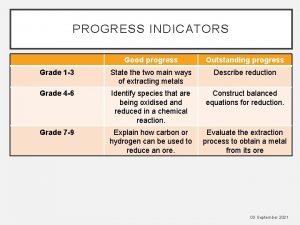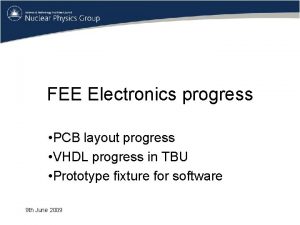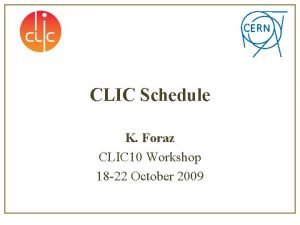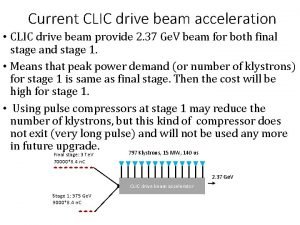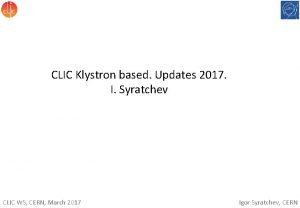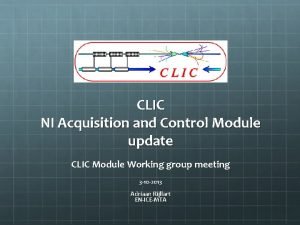PROGRESS on CLIC FF QD 0 Michele Modena



![Pure PM approach: “Halbach” vs. “Super Strong” performances: Permendur PM R=3. 8 [mm] (no Pure PM approach: “Halbach” vs. “Super Strong” performances: Permendur PM R=3. 8 [mm] (no](https://slidetodoc.com/presentation_image/5032cde3e60033af8ae4b3c9830cf67e/image-4.jpg)
![“Pure Electro-Magnetic” approach: Yoke material-ST 1010, Bs=2. 1 [T] Grad=310 T/m ( NI= 5000 “Pure Electro-Magnetic” approach: Yoke material-ST 1010, Bs=2. 1 [T] Grad=310 T/m ( NI= 5000](https://slidetodoc.com/presentation_image/5032cde3e60033af8ae4b3c9830cf67e/image-5.jpg)

![“Hybrid” approach, Version 2: Iw=5000 [A] Grad [T/m] Sm 2 Co 17 531 Grad “Hybrid” approach, Version 2: Iw=5000 [A] Grad [T/m] Sm 2 Co 17 531 Grad](https://slidetodoc.com/presentation_image/5032cde3e60033af8ae4b3c9830cf67e/image-7.jpg)

![Resuming : Hybrid magnet Iw=5000 A (Tunable) PM Material R=4. 125 [mm] Sm 2 Resuming : Hybrid magnet Iw=5000 A (Tunable) PM Material R=4. 125 [mm] Sm 2](https://slidetodoc.com/presentation_image/5032cde3e60033af8ae4b3c9830cf67e/image-9.jpg)
![“Hybrid Short Prototype” (Version 2): Conductor ID (ex. from “LUVATA” Catalogue) height/width [mm] hole “Hybrid Short Prototype” (Version 2): Conductor ID (ex. from “LUVATA” Catalogue) height/width [mm] hole](https://slidetodoc.com/presentation_image/5032cde3e60033af8ae4b3c9830cf67e/image-10.jpg)












![Resuming : PM magnets (NOT Tunable) Material R=4. 125 [mm] Sm 2 Co 17 Resuming : PM magnets (NOT Tunable) Material R=4. 125 [mm] Sm 2 Co 17](https://slidetodoc.com/presentation_image/5032cde3e60033af8ae4b3c9830cf67e/image-23.jpg)

- Slides: 24

“PROGRESS on CLIC FF (QD 0) ” Michele Modena - CERN “CLIC Weekly Meeting” on 30 Oct 2009, M. Modena

• In a “CLIC-MDI” Meetings, on 27 Aug 2009, we presented a proposal for an hybrid design for the QD 0 (the subject was also presented two weeks ago at the “CLIC 09 Workshop” and majority of the slides presented here adapted from August and October presentations). • New developments of the last months are: - Enlarging discussions with other actors and starting to take into account: – Detector design and interfaces – Anti-solenoid presence – Stabilization requirements - Work on a more “adapted design” of the QD 0, eventually with reduced or zero impact of the coils water cooling (for stabilization reasons) “CLIC Weekly Meeting” on 30 Oct 2009, M. Modena - Contacts with potential Suppliers in order to build ASAP a 1 st short prototype to prove and validate the hybrid QDO conceptual design. 2

“Nominal” Requirements for CLIC FF Quad (for L* = 3. 5 m layout): • Gradient: highest possible towards a nominal value of: 575 T/m ) • Required Length: 2. 73 m (… under discussion how to eventually split this length in different “magnet slots” …) • Magnet Bore Radius: 3. 8 mm + 0. 3 mm (as estimated with Vacuum Group for a vacuum chamber thickness) + 0. 025 of tolerance = 4. 125 mm • Field Quality: a 1 st requirement exist, but to be further discussed with CLIC Beam Physic Group • Geometric (layout) boundary conditions: Major one is: presence of the “spent beam pipe”: conical shape (10 mrad aperture), min. distance from the FF (at the front end for a L* = 3. 5 m): 35 mm “CLIC Weekly Meeting” on 30 Oct 2009, M. Modena 3
![Pure PM approach Halbach vs Super Strong performances Permendur PM R3 8 mm no Pure PM approach: “Halbach” vs. “Super Strong” performances: Permendur PM R=3. 8 [mm] (no](https://slidetodoc.com/presentation_image/5032cde3e60033af8ae4b3c9830cf67e/image-4.jpg)
Pure PM approach: “Halbach” vs. “Super Strong” performances: Permendur PM R=3. 8 [mm] (no chamber) Material R=4. 125 [mm] Sm 2 Co 17 Nd 2 Fe 14 B Sm Co Nd Fe B Grad [T/m] “Halbach” 450 593 409 540 Grad [T/m] “Super Strong” 564 678 512 615 17 on 30 Oct 2009, 2 M. 14 Modena “CLIC Weekly 2 Meeting” (Courtesy A. Vorozhtsov) 4
![Pure ElectroMagnetic approach Yoke materialST 1010 Bs2 1 T Grad310 Tm NI 5000 “Pure Electro-Magnetic” approach: Yoke material-ST 1010, Bs=2. 1 [T] Grad=310 T/m ( NI= 5000](https://slidetodoc.com/presentation_image/5032cde3e60033af8ae4b3c9830cf67e/image-5.jpg)
“Pure Electro-Magnetic” approach: Yoke material-ST 1010, Bs=2. 1 [T] Grad=310 T/m ( NI= 5000 A ) -“ 8 shape” quad design: (it permits to accommodate the spent beam pipe) - Saturation appears (with both materials) Yoke material-Permendur, “CLIC Weekly Meeting” on 30 Oct[T] 2009, M. Modena Bs=2. 35 Grad=365 T/m (Opera 2 D simulation. Courtesy A. Vorozhtsov) 5

“Hybrid” approach, Version 1: “CLIC Weekly Meeting” on 30 Oct 2009, M. Modena Iw=5000 [A] Grad [T/m] Sm 2 Co 17 550 -Presence of PM wedges reduce Grad [T/m] Nd 2 Fe 14 B 615 strongly saturation in the poles Gradient increase of a factor 1. 5 -1. 68 (Opera 2 D simulation. Courtesy A. Vorozhtsov) 6
![Hybrid approach Version 2 Iw5000 A Grad Tm Sm 2 Co 17 531 Grad “Hybrid” approach, Version 2: Iw=5000 [A] Grad [T/m] Sm 2 Co 17 531 Grad](https://slidetodoc.com/presentation_image/5032cde3e60033af8ae4b3c9830cf67e/image-7.jpg)
“Hybrid” approach, Version 2: Iw=5000 [A] Grad [T/m] Sm 2 Co 17 531 Grad [T/m] Nd 2 Fe 14 B 599 - The presence of the “ring” decrease slightly the“CLIC Gradient (by 15 -20 T/m) Weekly Meeting” on 30 Oct 2009, M. Modena but will assure a more precise and stiff assembly - EM Coils design will permit wide operation conditions (with or without water cooling) that can be critical for performances (ex. stabilization) 7

“Hybrid” approach, Version 2: Field quality Gradient azimuthal homogeneity at R=1 mm “CLIC Weekly Meeting” on 30 Oct 2009, M. Modena (Opera 2 D simulation. Courtesy A. Vorozhtsov) 8
![Resuming Hybrid magnet Iw5000 A Tunable PM Material R4 125 mm Sm 2 Resuming : Hybrid magnet Iw=5000 A (Tunable) PM Material R=4. 125 [mm] Sm 2](https://slidetodoc.com/presentation_image/5032cde3e60033af8ae4b3c9830cf67e/image-9.jpg)
Resuming : Hybrid magnet Iw=5000 A (Tunable) PM Material R=4. 125 [mm] Sm 2 Co 17 Nd 2 Fe 14 B Yoke Material ST 1010 and Permendur Grad [T/m] Version 1 550 615 Grad [T/m] Version 2 (SOLID CENTRAL RING) 531 599 For our application Sm 2 Co 17 choice should be probably the preferable because: - High Curie temp. ( vacuum chamber baking-out should be not a problem up to 250 °C) - Sm. Co alloys are the most resistant to radiations (radiation dose estimation studies are now starting) “CLIC Weekly Meeting” on 30 Oct 2009, M. Modena - The material should not degrade and remain stable inside the magnetic field created by the EM coils (5 -8 k. Oe); checks are ongoing with the PM possible Supplier. 9
![Hybrid Short Prototype Version 2 Conductor ID ex from LUVATA Catalogue heightwidth mm hole “Hybrid Short Prototype” (Version 2): Conductor ID (ex. from “LUVATA” Catalogue) height/width [mm] hole](https://slidetodoc.com/presentation_image/5032cde3e60033af8ae4b3c9830cf67e/image-10.jpg)
“Hybrid Short Prototype” (Version 2): Conductor ID (ex. from “LUVATA” Catalogue) height/width [mm] hole diameter [mm] x/y [mm] R [mm] N turns per pole Conductor Length [m] per pole for 1 m magnet 6822 15. 4/10 4. 0 5. 70/3. 00 1. 50 “CLIC Weekly Meeting” on 30 Oct 2009, M. Modena 12 28. 5 Minimal bending radius [mm] 20 Insulation thickness [mm] 0. 5 Mass per m (Drawings: courtesy E. Solodko) 1. 25 kg/m 10

“Hybrid Short Prototype”: “CLIC Weekly Meeting” on 30 Oct 2009, M. Modena 11

“Hybrid Short Prototype Ver. 3” Dimensions increased from 35 mm to 52 mm “CLIC Weekly Meeting” on 30 Oct 2009, M. Modena 12

“Hybrid Short Prototype Ver. 3”: Covers (for safety reasons: blocking the PM wedges) “CLIC Weekly Meeting” on 30 Oct 2009, M. Modena 13

…Towards a more “adapted” design (…still as CONCEPTUAL design!): 1) Reduce the current density in the coil (and consequently the coil cross-section) to be free from cooling water (at least in turbulent regime). The proposed cross section must have J ≤ 1. 5 A/mm 2. 1) Anyway, the presence of a “cooling circuit” is expected for a “thermalization” more than for a real coil cooling. This will also depends by the design of the support beam. 1) The presence of some “thermalization plates” will also provide higher rigidity to the coil assembly (remind that the coils could be quite long in the final magnet(s) since 2. 73 m of total length for the QD 0 element(s) are required). “CLIC Weekly Meeting” on 30 Oct 2009, M. Modena 14

… Towards a more “adapted” design (“Slim Version” conceptual design…) Plates for eventual thermalization of the coil and for stiffening of the coil pancakes coils supporting fully independent from iron supporting Support/stabilization system “CLIC Weekly Meeting” on 30 Oct 2009, M. Modena QD 0 Support Beam Coil copper conductor (ex. 4 x 4 mm). Nominal J= 1. 5 A/mm 2 (Drawings: courtesy E. Solodko) 15

… Towards a more “adapted” design (“Slim Version” conceptual design…) “CLIC Weekly Meeting” on 30 Oct 2009, M. Modena 16

… Towards a more “adapted” design (“Square Version” conceptual design…) “CLIC Weekly Meeting” on 30 Oct 2009, M. Modena 17

… Towards a more “adapted” design (“Square Version” conceptual design…) Support/stabilization system “CLIC Weekly Meeting” on 30 Oct 2009, M. Modena 18

Thanks for your the attention! “CLIC Weekly Meeting” on 30 Oct 2009, M. Modena 19

(extra slides) “CLIC Weekly Meeting” on 30 Oct 2009, M. Modena 20

“Halbach type” approach: “CLIC Weekly Meeting” on 30 Oct 2009, M. Modena (Opera 2 D simulation. Courtesy A. Vorozhtsov) 21

“Halbach type” approach: achievable gradients “CLIC Weekly Meeting” on 30 Oct 2009, M. Modena 22
![Resuming PM magnets NOT Tunable Material R4 125 mm Sm 2 Co 17 Resuming : PM magnets (NOT Tunable) Material R=4. 125 [mm] Sm 2 Co 17](https://slidetodoc.com/presentation_image/5032cde3e60033af8ae4b3c9830cf67e/image-23.jpg)
Resuming : PM magnets (NOT Tunable) Material R=4. 125 [mm] Sm 2 Co 17 Nd 2 Fe 14 B Grad [T/m] “Halbach” 409 540 Grad [T/m] “Super. Strong” 512 615 NC magnets Iw=5000 A (Tunable) Material Grad [T/m] R=4. 125 [mm] ST 1010 Permendur 310 366 Hybrid magnet Iw=5000 A (Tunable) PM Material R=4. 125 [mm] Sm 2 Co 17 Nd 2 Fe 14 B Yoke Material ST 1010 and Permendur Grad [T/m] Version 1 550 615 “CLIC Weekly Meeting” on 30 Oct 2009, M. Modena Grad [T/m] Version 2 (SOLID CENTRAL RING) 531 599 - For our application Sm 2 Co 17 choice could be preferable (higher radiation resistance) 23

As CERN “Magnet Group” we propose to go on ASAP with the construction of a 1 st short prototype. We several advantages in this. A FF quadrupole prototype (short model!) will be useful for : – for CLIC: To check the feasibility of a possible FF design approach. – for CERN: To let CERN-TE/MSC starting activities in PM magnet domain and more specifically: • Validation of a possible FF cross-section design • To investigate the difficulties for the high precision machining of the Permendur poles, the PM wedges, achievable tolerances, etc. • To investigates the role of tolerances between poles and PM wedges in terms of Gradient and Field Quality • Eventually, to tests different PM materials – for CERN/CLIC: Provide a magnet with a minimum bore aperture “CLIC Weekly Meeting” on 30 Oct 2009, systems. M. Modena to develop and test miniaturized magnetic measurement – … 24
 Michele modena
Michele modena Physical progress and financial progress
Physical progress and financial progress Clic paris emeraude
Clic paris emeraude Clic
Clic Alphabet protocananéen
Alphabet protocananéen Dead clic
Dead clic Soplos pansistolicos
Soplos pansistolicos Clic clac saint nicolas chanson
Clic clac saint nicolas chanson S4x clic
S4x clic Cern clic
Cern clic 1 clic reception
1 clic reception Clic
Clic Dead clic accounting
Dead clic accounting Mon dossier citoyen
Mon dossier citoyen Ingresar al sistema web res. 1102-404 y res. 785
Ingresar al sistema web res. 1102-404 y res. 785 Imagenes de clic
Imagenes de clic Cuantas letras hay
Cuantas letras hay Moic84200
Moic84200 Commissioni ing direct
Commissioni ing direct I.c. 10 modena
I.c. 10 modena Registro elettronico tassoni
Registro elettronico tassoni Iscra modena
Iscra modena Via razzaboni 80 modena
Via razzaboni 80 modena Stefano orsi modena suicida
Stefano orsi modena suicida Analisi e consulenza finanziaria modena
Analisi e consulenza finanziaria modena
